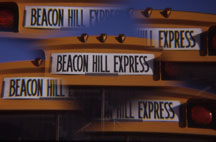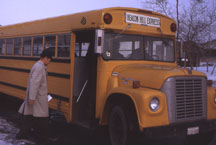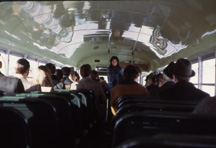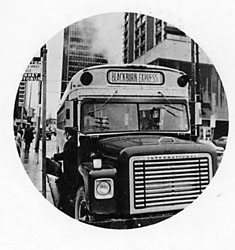|
Do-it-yourself Bus Service
If you work in the Ministry of Transport Headquarters
building in Ottawa (Place de Ville, Tower C), you may have looked down on
Queen Street and noticed the yellow school buses picking up people outside
Tower A. If you live in Beacon Hill or Blackburn Hamlet you know the bus
is one of the expresses that bring commuters to and from work. This bus service
was started by the Transport Committee of the Beacon Hill North Community
Association. Two of the part-time bus operators, Duncan Ellison and I, work
in the Surface Transportation Administration Ministry of Transport.
Transport Canada staff magazine December 1972Although Beacon Hill is only about seven miles from Place de Ville, it was discovered when we moved in that there was no bus service at all and so, like everybody else, we were forced into a car pool. The Community Association had been trying to get a bus service for several years, but because Beacon Hill was outside the city limits, the Ottawa Transportation Commission (OTC) was unwilling to provide a service. In June, 1971, Duncan Ellison joined the Community Association Transport Committee and I soon followed. A questionnaire circulated to all residents to help the committee identify the demand quickly established that the greatest need for public transport lay in getting people to work in the morning and in bringing them home in the evening. SEARCH UNDER WAY
Duncan began the search for a bus operator who could provide the service at a reasonable price, and it was soon decided to use Capital Coach Lines, a school bus operator in the area. The proposed service had to conform to several criteria. It had to be self-supporting (there could be no subsidy) and in order to be successful (and to break up the well-established car pools), it would have to be an express service. Also, in order to cover costs at an acceptable fare level, a 48-seater bus is needed to carry 56 passengers. The first bus left Beacon Hill at 0715 on July 5, 1971 and returned for a second trip at 0755. The first week saw an average of 63 passengers a day and easily covered their costs. On the second week, some of the buses were so overcrowded it was decided to add a second bus during the third week and at the same time extend service into Beacon Hill South. Those first few weeks were very hectic. Duncan and I rode both buses in the morning each day before work for two weeks, as well as most of the evening buses. While Duncan sold tickets I was keeping track of the time for an accurate timetable. "BEACON HILL BULLET"
The express feature of service which uses the Queensway has been a great success. The bus was quickly nicknamed the "Beacon Hill Bullet" and this name has stuck. It's the subject of a film called "A Bus For Us" produced by the National Film Board. The service experienced a slow increase all through August, 1971 and then a rapid expansion as people returned from vacations. By last Christmas we found ourselves to be members of a "non-profit group" with an annual turnover of approximately $150,000 and making a profit of some $10,000. "We haven't seen a penny of this profit," Duncan observed. There was some $3,500 by last Christmas and it was then decided to introduce an off-peak service for shoppers. We realized that it would lose money, but this has been absorbed from the profits earned by the express". Volunteer bus conductors were organized for each bus to sell and check tickets. As the service increased it became more and more difficult to organize, but it did ensure that the minimum of time was wasted by the drivers at bus stops. Another of the early jobs was to design the ticket system. A weekly pass cost $3.50 while a five-ride ticket was priced at $2.50. As the conductors were all volunteers, it wasn't possible to guarantee that each man would be on his assigned bus, because his boss might keep him late or he might just get up late. A "back-up" system of volunteers was also organized, so that if the regular conductor was absent, there was normally a back-up on the bus who could check the tickets. BLACKBURN HAMLET JOINS
The service was expanded in the period just before Christmas. The Blackburn Hamlet Community Association joined the scheme and express buses started to serve that community as well. The Beacon Hill buses were extended into Rothwell Heights and last March a shuttle bus was started in Carson Grove with a free transfer to the express. The bus started in Carson Grove before most of the houses were built, and so there was no need for car pools to be formed. At first the group lost about $1.50 per day on the Carson Grove bus, but traffic has built up so rapidly that the residents of Carson Grove may soon have their own direct express. Having demonstrated not only that people would use a good bus service but that such a service could cover its costs, the group has now handed over the complete operation to Capital Coach Lines. Our intention was only to provide a bus service for the community. We didn't want to run a bus company in our spare time. Duncan says he can "now read a paper on the bus without having to bother about selling tickets!" The committee still keeps in close contact with the bus company which invites suggestions for improvements. This is one of the rare cases where the provider of the service and the community worked very closely together for their mutual benefits. FROM 63 TO 700 PASSENGERS
How successful has the bus service been? From 63 passengers on the first day, the school buses now carry 700 in each direction daily. From studies made by we two Ministry of Transport economists passengers can be converted into some 500 cars that do not use the Queensway at peak periods and therefore don't contribute to Ottawa traffic congestion. We have also learned that eight per cent of the people travelling have no alternative form of transport. The company has purchased some new buses which, although still of school bus type, are much more suitable with better legroom, headroom and ventilation. The paint scheme is now a maroon and cream which easily distinguishes the new buses from the original yellow ones. The next time your car refuses to start in winter or you have to drag yourself out of bed early to shovel out the driveway, or you beg a ride from a neighbour because your wife needs the car for a doctor's appointment, just think of the Ottawa residents of Beacon Hill and other outlying communities who don't have these worries. Duncan Ellison and I have shown that if you don't have a bus service, you can do it yourself.
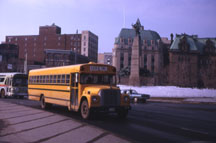
Back for the next load, the yellow school bus passing Confederation Square. |
Home Articles
